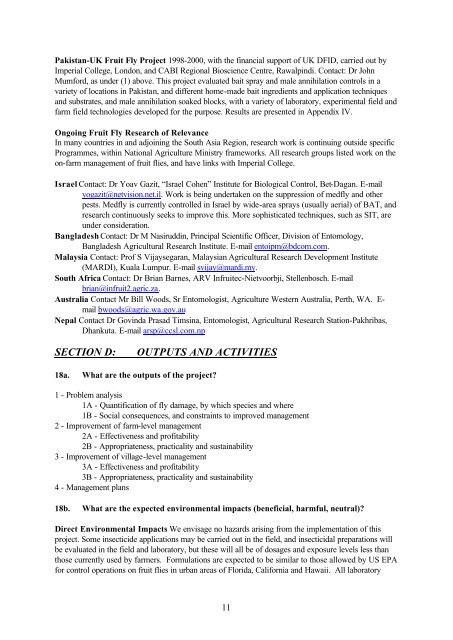“Key Informant Survey” of Production, Value, Losses and ... - DfID
“Key Informant Survey” of Production, Value, Losses and ... - DfID
“Key Informant Survey” of Production, Value, Losses and ... - DfID
You also want an ePaper? Increase the reach of your titles
YUMPU automatically turns print PDFs into web optimized ePapers that Google loves.
Pakistan-UK Fruit Fly Project 1998-2000, with the financial support <strong>of</strong> UK DFID, carried out by<br />
Imperial College, London, <strong>and</strong> CABI Regional Bioscience Centre, Rawalpindi. Contact: Dr John<br />
Mumford, as under (1) above. This project evaluated bait spray <strong>and</strong> male annihilation controls in a<br />
variety <strong>of</strong> locations in Pakistan, <strong>and</strong> different home-made bait ingredients <strong>and</strong> application techniques<br />
<strong>and</strong> substrates, <strong>and</strong> male annihilation soaked blocks, with a variety <strong>of</strong> laboratory, experimental field <strong>and</strong><br />
farm field technologies developed for the purpose. Results are presented in Appendix IV.<br />
Ongoing Fruit Fly Research <strong>of</strong> Relevance<br />
In many countries in <strong>and</strong> adjoining the South Asia Region, research work is continuing outside specific<br />
Programmes, within National Agriculture Ministry frameworks. All research groups listed work on the<br />
on-farm management <strong>of</strong> fruit flies, <strong>and</strong> have links with Imperial College.<br />
Israel Contact: Dr Yoav Gazit, “Israel Cohen” Institute for Biological Control, Bet-Dagan. E-mail<br />
yogazit@netvision.net.il. Work is being undertaken on the suppression <strong>of</strong> medfly <strong>and</strong> other<br />
pests. Medfly is currently controlled in Israel by wide-area sprays (usually aerial) <strong>of</strong> BAT, <strong>and</strong><br />
research continuously seeks to improve this. More sophisticated techniques, such as SIT, are<br />
under consideration.<br />
Bangladesh Contact: Dr M Nasiruddin, Principal Scientific Officer, Division <strong>of</strong> Entomology,<br />
Bangladesh Agricultural Research Institute. E-mail entoipm@bdcom.com.<br />
Malaysia Contact: Pr<strong>of</strong> S Vijaysegaran, Malaysian Agricultural Research Development Institute<br />
(MARDI), Kuala Lumpur. E-mail svijay@mardi.my.<br />
South Africa Contact: Dr Brian Barnes, ARV Infruitec-Nietvoorbji, Stellenbosch. E-mail<br />
brian@infruit2.agric.za.<br />
Australia Contact Mr Bill Woods, Sr Entomologist, Agriculture Western Australia, Perth, WA. Email<br />
bwoods@agric.wa.gov.au<br />
Nepal Contact Dr Govinda Prasad Timsina, Entomologist, Agricultural Research Station-Pakhribas,<br />
Dhankuta. E-mail arsp@ccsl.com.np<br />
SECTION D: OUTPUTS AND ACTIVITIES<br />
18a. What are the outputs <strong>of</strong> the project?<br />
1 - Problem analysis<br />
1A - Quantification <strong>of</strong> fly damage, by which species <strong>and</strong> where<br />
1B - Social consequences, <strong>and</strong> constraints to improved management<br />
2 - Improvement <strong>of</strong> farm-level management<br />
2A - Effectiveness <strong>and</strong> pr<strong>of</strong>itability<br />
2B - Appropriateness, practicality <strong>and</strong> sustainability<br />
3 - Improvement <strong>of</strong> village-level management<br />
3A - Effectiveness <strong>and</strong> pr<strong>of</strong>itability<br />
3B - Appropriateness, practicality <strong>and</strong> sustainability<br />
4 - Management plans<br />
18b. What are the expected environmental impacts (beneficial, harmful, neutral)?<br />
Direct Environmental Impacts We envisage no hazards arising from the implementation <strong>of</strong> this<br />
project. Some insecticide applications may be carried out in the field, <strong>and</strong> insecticidal preparations will<br />
be evaluated in the field <strong>and</strong> laboratory, but these will all be <strong>of</strong> dosages <strong>and</strong> exposure levels less than<br />
those currently used by farmers. Formulations are expected to be similar to those allowed by US EPA<br />
for control operations on fruit flies in urban areas <strong>of</strong> Florida, California <strong>and</strong> Hawaii. All laboratory<br />
11

















